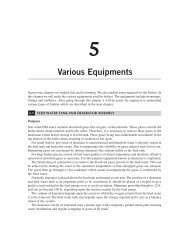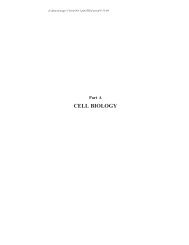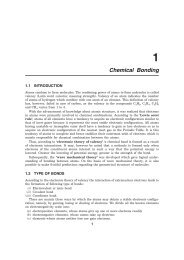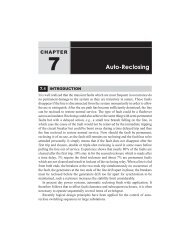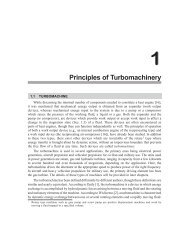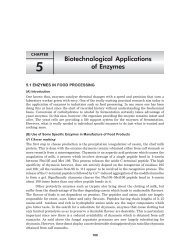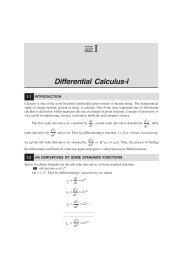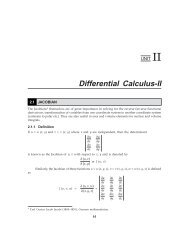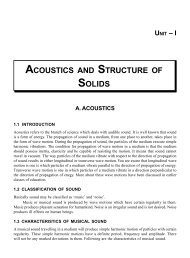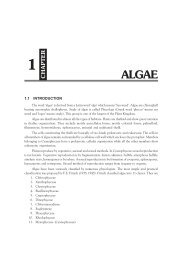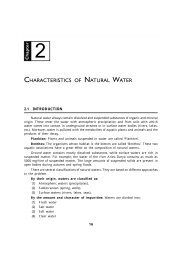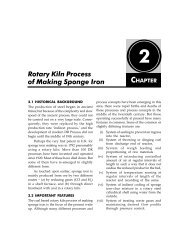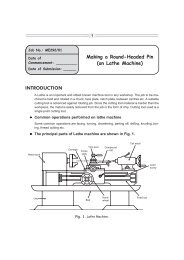Determination of Sulphate and Sulphide - New Age International
Determination of Sulphate and Sulphide - New Age International
Determination of Sulphate and Sulphide - New Age International
Create successful ePaper yourself
Turn your PDF publications into a flip-book with our unique Google optimized e-Paper software.
Experiment No. ___________________ Date ___________________<br />
DETERMINATION OF SULPHATE AND SULPHIDE<br />
A. DETERMINATION OF SULPHATE<br />
Aim<br />
To determine the amount <strong>of</strong> sulphate present in the given samples.<br />
Principle<br />
<strong>Sulphate</strong> is widely distributed in nature <strong>and</strong> may be present in natural water in concentrations ranging from a few to<br />
several thous<strong>and</strong> milligrams/litre. <strong>Sulphate</strong>s are <strong>of</strong> considerable concern because they are indirectly responsible for<br />
two serious problems <strong>of</strong>ten associated with the h<strong>and</strong>ling <strong>and</strong> treatment <strong>of</strong> wastewater. Odour <strong>and</strong> sewer corrosion<br />
problem result from the reduction <strong>of</strong> sulphates to hydrogen sulphide under anaerobic conditions.<br />
<strong>Sulphate</strong>s can be determined by<br />
1. Gravimetric method with ignition <strong>of</strong> residue.<br />
2. Gravimetric method with drying <strong>of</strong> residue.<br />
3. Turbidimetric method.<br />
1. Gravimetric Method with Ignition <strong>of</strong> Residue<br />
Principle<br />
<strong>Sulphate</strong> is precipitated in hydrochloric acid medium as barium sulphates by the addition <strong>of</strong> barium chloride. The<br />
precipitation is carried out near the boiling temperature <strong>and</strong> after a period <strong>of</strong> digestion the precipitate is filtered;<br />
washed with water until free <strong>of</strong> chlorides, ignited <strong>and</strong> weighed as barium sulphates.<br />
Apparatus<br />
1. Drying oven 2. Desiccator<br />
3. Steam bath 4. Analytical balance<br />
5. Ashless filter paper (Whatman filter paper No. 42)
48 A Comprehensive Laboratory Manual for Environmental Science <strong>and</strong> Engineering<br />
6. Muffle furnace<br />
7. Glassware like funnel, flask <strong>and</strong> pipette<br />
Reagents<br />
1. Methyl red indicator solution<br />
2. Hydrochloric acid<br />
3. Barium chloride solution. Gravimetric method with drying <strong>of</strong> residue.<br />
4. Silver nitrate–nitric acid reagent<br />
Procedure<br />
1. Take 250 mL <strong>of</strong> the sample in a conical flask.<br />
2. Adjust the acidity with HCl to 4.5 to 5 using a pH meter or the orange colour <strong>of</strong> methyl red indicator.<br />
3. Then add an additional 1 to 2mL HCl.<br />
4. Heat the solution to boiling <strong>and</strong> while stirring gently, add barium chloride solution slowly until precipitation<br />
appear to be completed. Then add about 2 mL in excess.<br />
5. Digest the precipitate at 80°C to 90°C preferably overnight but for not less than<br />
2 hours.<br />
6. Filter the contents in the flask through an ashless filter paper.<br />
7. Wash the precipitate with small portion <strong>of</strong> warm distilled water until the washing is free <strong>of</strong> chloride as<br />
indicated by testing with silver nitrate–nitric acid reagent.<br />
8. Place the precipitate along with filter paper in a crucible after finding its empty weight <strong>and</strong> dry it.<br />
9. Keep the crucible in a muffle furnace <strong>and</strong> ignite at 800°C for 1 hour.<br />
10. Cool in a desiccator <strong>and</strong> weigh.<br />
11. Find weight <strong>of</strong> the barium sulphate precipitate.<br />
2. Gravimetric Method with Drying <strong>of</strong> Residue<br />
If organic matter is not present in the sample, first method can be done without igniting <strong>and</strong> instead drying the<br />
residue <strong>and</strong> weighing.<br />
3. Turbidimetric Method<br />
Principle<br />
The turbidimetric method <strong>of</strong> measuring sulphate is based upon the fact that barium sulphate tends to precipitate in<br />
a colloidal form <strong>and</strong> that this tendency is enhanced in presence <strong>of</strong> a sodium chloride—hydrochloric acid solution<br />
containing glycerol <strong>and</strong> other organic compounds. The absorbance <strong>of</strong> the barium sulphate solution is measured by<br />
a nephelometer or turbidimeter <strong>and</strong> the sulphate iron concentration, determined by comparison <strong>of</strong> the reading with<br />
a st<strong>and</strong>ard curve.<br />
Apparatus<br />
1. Nephelometer or Turbidimeter<br />
2. Magnetic stirrer
<strong>Determination</strong> <strong>of</strong> <strong>Sulphate</strong> <strong>and</strong> <strong>Sulphide</strong> 49<br />
3. Stopwatch<br />
4. Measuring spoon 0.2 to 0.3 mL capacity.<br />
Reagents<br />
1. Conditioning agent<br />
2. Barium chloride<br />
3. St<strong>and</strong>ard sulphate solution<br />
Procedure<br />
1. Measure 100 mL or suitable portion <strong>of</strong> the sample into a 250 mL Erlenmeyer flask.<br />
2. Add 5 mL <strong>of</strong> conditioning reagent <strong>and</strong> mix it by placing on a magnetic stirrer.<br />
3. Add a spoonful <strong>of</strong> barium chloride crystals <strong>and</strong> begin timing immediately.<br />
4. Stir at constant speed exactly for one minute.<br />
5. After stirring pour some <strong>of</strong> the solution into the absorption cell <strong>of</strong> the photometer, <strong>and</strong> measure the<br />
turbidity at 30 second intervals for four minutes.<br />
6. Usually maximum turbidity occurs within two minutes <strong>and</strong> the reading remains constant thereafter for<br />
3 to 10 minutes. So, take reading with maximum turbidity occurring in within four minutes.<br />
7. Prepare a calibration curve. The st<strong>and</strong>ards are prepared at 5 mg/L increments in the<br />
0–40 mg/L sulphate range <strong>and</strong> their turbidity or absorbance read.<br />
8. Absorbance versus sulphate concentration is plotted <strong>and</strong> a curve is obtained.<br />
9. Finding the absorbance for a given sample, the concentration <strong>of</strong> sulphates in the solution is determined<br />
with the help <strong>of</strong> calibration curve.<br />
Observation<br />
Sample no. or Volume <strong>of</strong> the Empty weight Wt. <strong>of</strong> crucible + Wt. <strong>of</strong> BaSO 4<br />
mg/L<br />
description sample (mL) <strong>of</strong> the crucible residue after ignition precipitated SO 4<br />
+ filter paper + filter paper<br />
Weight <strong>of</strong> filter paper = ...........
50 A Comprehensive Laboratory Manual for Environmental Science <strong>and</strong> Engineering<br />
Calculation<br />
Results<br />
mg <strong>of</strong> BaSO<br />
SO 4<br />
in mg/L =<br />
4<br />
411.6<br />
mL <strong>of</strong> sample × =.........<br />
Sample no. or description mg/L <strong>of</strong> SO 4<br />
Discussion<br />
B. DETERMINATION OF SULPHIDE<br />
Aim<br />
To determine the amount <strong>of</strong> sulphide present in the sample by titrimetric method.<br />
Principle<br />
<strong>Sulphide</strong>s <strong>of</strong>ten occur in ground water especially in hot springs, in wastewater <strong>and</strong> polluted waters. Hydrogen<br />
sulphide escaping into the air from sulphide containing wastewater causes odour nuisance. It is highly toxic <strong>and</strong><br />
cause corrosion <strong>of</strong> sewers <strong>and</strong> pipes. <strong>Sulphide</strong>s include H 2<br />
S <strong>and</strong> HS – <strong>and</strong> acid soluble metallic sulphides present in<br />
the suspended matter.<br />
Iodine reacts with sulphide in acid solution, oxidising it to sulphur; a titration based on this reaction is an<br />
accurate method for determining sulphides at concentration above 1mg/L if interferences are absent <strong>and</strong> if loss <strong>of</strong><br />
H 2<br />
S is avoided.
<strong>Determination</strong> <strong>of</strong> <strong>Sulphate</strong> <strong>and</strong> <strong>Sulphide</strong> 51<br />
Apparatus<br />
1. Burette<br />
2. Pipette<br />
3. Erlenmeyer flask.<br />
Reagents<br />
1. Hydrochloric acid<br />
2. St<strong>and</strong>ard iodine solution (0.025N)<br />
3. St<strong>and</strong>ard sodium thiosulphate solution (0.025N)<br />
4. Starch solution<br />
Procedure<br />
1. Measure from a burette 10mL <strong>of</strong> iodine into a 500 mL flask.<br />
2. Add distilled water <strong>and</strong> bring the volume to 20 mL.<br />
3. Add 2 mL <strong>of</strong> 6 N HCl.<br />
4. Pipette 200 mL sample into the flask, discharging the sample under the surface <strong>of</strong> solution.<br />
5. If the iodine colour disappears, add more iodine so that the colour remains.<br />
6. Titrate with sodium thiosulphate solution, adding a few drops <strong>of</strong> starch solution, as the end point is<br />
approached <strong>and</strong> continuing until the blue colour disappears.<br />
Observation<br />
Sample no. or Volume <strong>of</strong> iodine Volume <strong>of</strong> sodium Volume <strong>of</strong> mg/L<br />
description solution used (a mL) thiosulphate solution sample used sulphide<br />
used (b mL)<br />
Calculation<br />
mg/L sulphide =<br />
400 (a – b)<br />
mL <strong>of</strong> sample<br />
where,<br />
a = mL 0.025 N iodine used<br />
b = mL 0.025 N sodium thiosulphate solution used.
52 A Comprehensive Laboratory Manual for Environmental Science <strong>and</strong> Engineering<br />
Results<br />
Sample no. or description<br />
mg/L (<strong>Sulphide</strong>) in the sample<br />
Discussion<br />
Questions<br />
1. What is the significance <strong>of</strong> high sulphate concentration in water supplies <strong>and</strong> in wastewater disposal?<br />
2. What is the purpose <strong>of</strong> digestion <strong>of</strong> the sample in the gravimetric analysis for sulphates?<br />
3. Explain the significance <strong>of</strong> the determination <strong>of</strong> sulphide concentration in environmental engineering.<br />
4. The water to be used for the preparation <strong>of</strong> cement concrete products should be free from excess <strong>of</strong><br />
sulphates <strong>and</strong> chlorides. Why?



